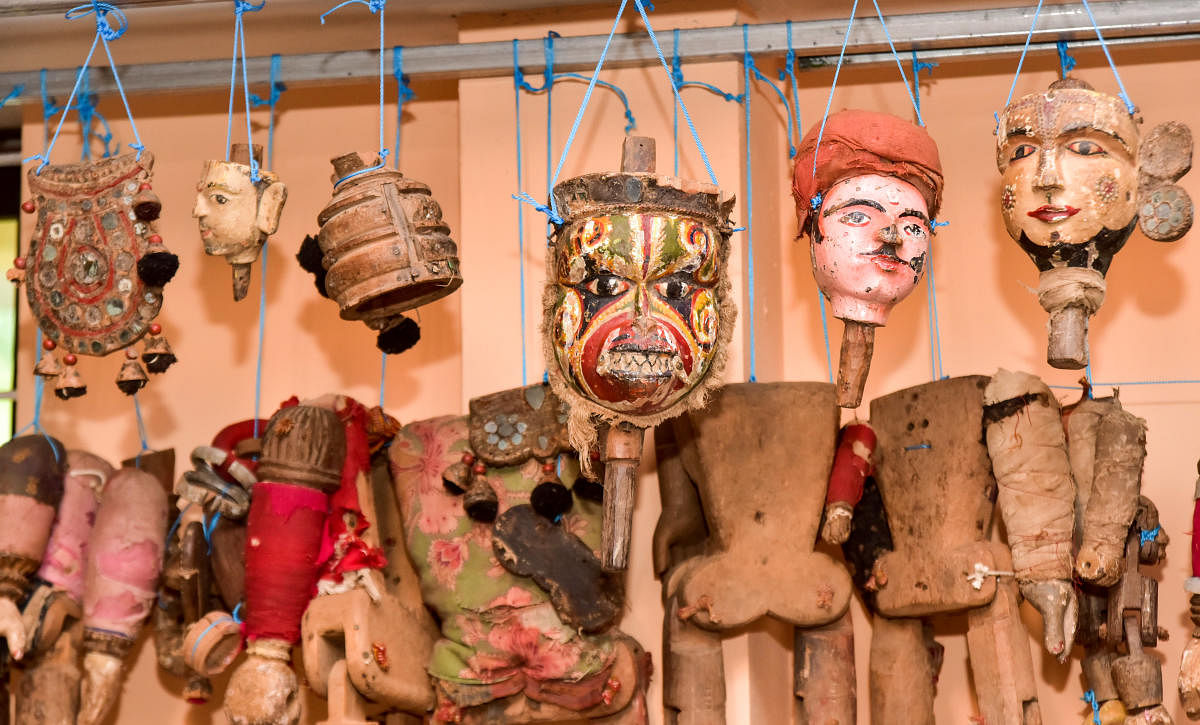




Outside, heavy rain pounds the rooftops. But all eyes inside the Ranganatha Sabha Bhavan, in Siddapura in Kundapur taluk, remain fixed on stage. Children and adults have crowded the hall, waiting to watch a show of Yakshagana puppetry after around two years.
Also called Yakshagana Gombeyata, this stringed puppet play is now helmed by a sixth generation puppeteer (sutradhara) Bhaskara Kogga Kamath, who quit his banking job to continue the family tradition. His father Kogga Kamath was an award-winning master puppeteer and in the last two decades, Bhaskar has taken the art to new heights.
Silence pervades the hall as the tiny curtains are drawn aside and the Yakshagana stringed puppet play, Chudamani Lankadahana, begins with the opening song — Ganapathi Vandana. As the play progresses, the live music, the deft movements of the puppeteers blurs reality, making the lifeless Yakshagana puppets leap to life.
The audience roars with delight as Hanuman takes flight with his tail on fire and burns down Lanka. The backstage buzzes with intense activity as Bhaskar is not only manipulating strings (each puppet is operated by six strings and an additional string is added if puppet is holding a sword) but is also dancing with anklets on, to make puppet dance authentic to the audience.
After bringing the audience under the puppet’s spell for nearly two hours, the play ends with a Mangalam just like that of a Yakshagana play. Exhausted, Bhaskar heaves a sigh of relief. The troupe, Sri Ganesha Yakshagana Gombeyata Mandali, Uppinakudru, includes 10 to 15 members. Some members tie anklets and act as puppeteers, while the remaining team up as himmela to provide live music.
"We have staged plays over a thousand times, but every show is a litmus test," Bhaskar says. So they make it a point to get the audience's feedback through a form.
This puppetry in Siddapura was the second in a series of 25 plays being planned under a special coastal tour, 'Walkthrough of Puppets’, in 25 different villages spread across four taluks in Udupi district from November 5 to December 19.
The tour is being organised to mark the silver jubilee year of Uppinakudru Sri Devanna Padmanabha Kamath Memorial Yakshagana Gombeyata Trust and the centenary year of Master puppeteer Kogga Devanna Kamath.
According to folk art experts, the origin of Yakshagana puppetry has not been established. Though it remained with a few families, Yakshagana puppetry has survived for over three centuries, due to Uppinakudru Kamath family's commitment to the art. In the 17th century, Krishna (Babu) Kamath and his son Lakshmana Bhagavatha launched the Yakshagana puppet theatre and travelled from place to place staging shows at fairs, temple festivals and so on.
It was Lakshmana who founded the Ganesha Yakshagana Gombeyata troupe.
Bhaskar Kogga Kamath's grandfather and fourth generation puppeteer Devanna Padmanabha Kamath ended up being the only one to practice the art handed down by his ancestors.
Acute poverty and the lack of patronage forced Devanna to wind up his puppet theatre in 1941.
In 1966, it was Kamaladevi Chattopadhyay (serving as Chairman of All India Handicrafts Board) who encouraged 75-year-old Devanna to revive the Yakshagana puppetry. He was also honoured by the President of India during Republic day celebrations in 1966.
Devanna's son Kogga Devanna Kamath, a wizard and artiste of high calibre, introduced many innovations (experimented with torch-bearing puppets like Hanuman setting Lanka on fire, depicting emotions on the puppets and so on) which drew world-wide acclaim. His troupe also participated in the fifth traditional arts festival at Rennes in France in 1978 with the help of K S Upadhyaya, a writer who organised tours in foreign coutries for the troupe.
Over the years, his son Bhaskar Kogga Kamath continued to add innovations in techniques to help Yakshagana puppetry endear itself to the present audience.
Puppetry tours
Such tours are not new to Bhaskar. In 2008 and 2017, Bhaskar and his troupe staged shows in 26 districts across Karnataka and in 22 schools from Kumta to Kasargod (Kerala) respectively.
“Unlike previous tours, this is a comeback tour. We were without work for two years and this is also an opportunity to popularise Yakshagana puppet theatre,” he says.
So far, Bhaskar and his team have also staged shows in 25 foreign countries.
The troupe, which used to perform 10 prasangas, has now reduced it to three prasangas. The number of puppets has declined from 300 to about 75.
But that hasn't stopped Bhaskar from setting up the Puppet Academy and Puppet House in his native village, Uppinakudru near Kundapur, with the support of Infosys Foundation and Century Builders.
At this puppet house, children are trained in puppetry art, shows are staged once a month and senior puppeteers are felicitated.
"The number of Yakshagana puppetry troupes declined from over 31 in 1988 to just handful of puppetry troupes in 2021. As puppetry art is endangered, government must set up a theme park dedicated to Yakshagana puppetry and set up a Puppetry authority to safeguard the traditional folk art," says S A Krishnaiah, the author of Karnataka Puppetry published in 1988.
Bhaskar says that in the first few days of coastal tour, he realised that society has not neglected Yakshagana puppetry, which still revolves around mythologies.
Deccan Herald is on WhatsApp Channels| Join now for Breaking News & Editor's Picks